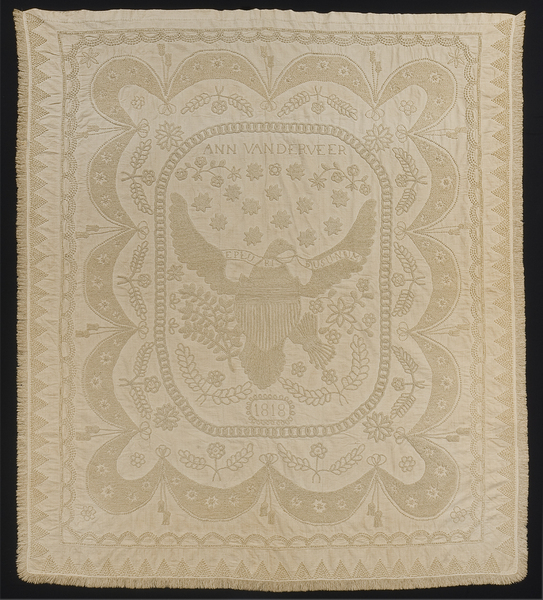
1818 Bedspread by Ann Vanderveer.
1998.0501 Courtesy of Winterthur Museum
The Subtle Elegance of Whitework
by Lilo Bowman
Candlewicking, or whitework, has been around for as long as women have taken thread to woven fabric. It seems, like most styles of threadwork, to come and go with the tastes and fashions of the time. Last fall, we spotted two stunning, award-winning quilts at the International Quilt Festival in Houston, that featured elements of whitework in their designs. As a result, we decided to share a little bit of history about this very subtle, yet eye-catching work.
The term whitework describes embroidery done on white fabric using white thread; it has always been one of the best ways for a needleworker to show off her skills. Worked in the very same, soft-spun thread as that used for for candle wicks, the project, once completed, would be washed in very hot water to shrink the fabric, while at the same time fluffing up and locking in the stitches. Generally, the embroidery was done on 100-percent unbleached cotton muslin, but the Ann Vanderveer piece shown above was done on a linen/cotton fabric called dimity; its warp is linen, while the weft is woven with a heavier cotton.
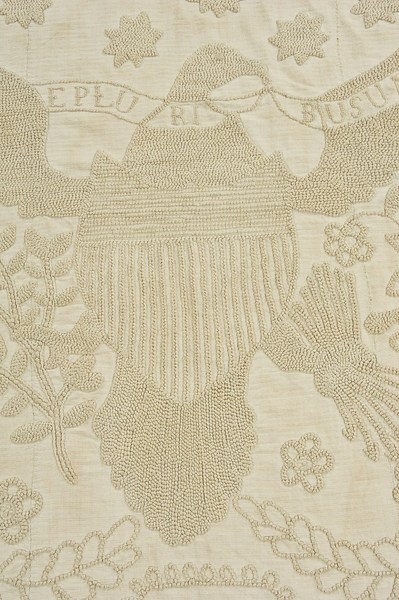
Ann Vanderveer (1818)998_0501 detail 6. Courtesy of Winterthur Museum
This beautiful bedcover features a spread-winged eagle (shown above) bearing olive branches and arrows in his talons, with the words "E PLURIBUS UNUM" embroidered on a banner in his beak. Amazingly, the embroidery designs--including swags, flowers, sawtooth points and tassels--are worked almost entirely in French knots (see the detail below).
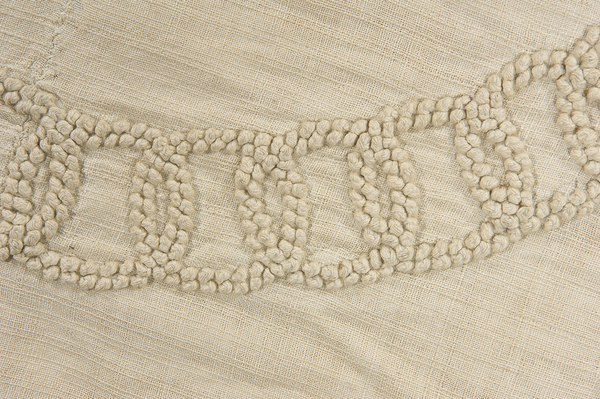
Ann Vanderveer (1818)1998_0501 detail 1. Courtesy of Winterthur Museum
Three sides of the bedcover are edged in woven cotton fringe, while the top has been hemmed. The entire piece measures approximately 34" wide and was constructed in three seamed panels. Originally, a plain cotton batting would have covered the back of the bedcovering.
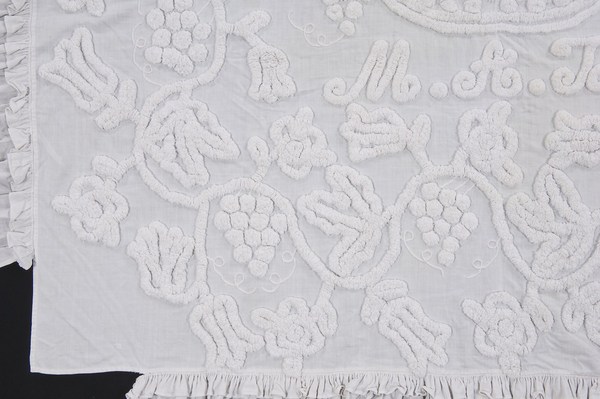
M. A. Todd (circa 1837)2000_0028_002 detail 7. Courtesy of Winterthur Museum
Whitework generally consisted of three-dimensional effects created with three types of stitches: tufting, knotting, or couching. "Tufted areas are made by running threads through the background material with running, satin, or cross-stitches. These stitches are raised from the surface in loops by passing the yarn over a spacer, such as a dowel or twig. After the spacer has been removed, the loops may be cut so that the strands of candlewicking stand straight up or contoured by shearing the pile. The roving remains firmly in place after the fabric is washed in hot water; as the fabric shrinks, the tufts of candlewicking are pulled together into tight balls." (Piecework, 1997)
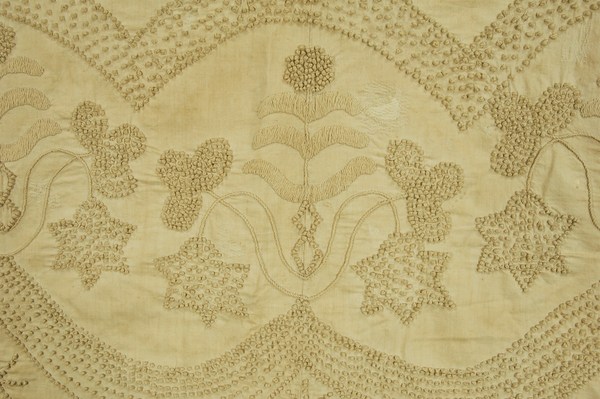
A R/3" (1800-1850) 1952_0345_005 detail 2. Courtesy of Winterthur Museum
French knots are small round knots created by wrapping the needle several times with the thread before the needle is re-inserted into the background fabric. French knots were used to fill large design areas or as an outlining device. Couching, wherein thread is laid and then tacked down at regular intervals, provided another, more subtle design element.
While these coverings certainly would have served a necessary utilitarian purpose, they also offered the creator the opportunity to showcase design elements that she felt important. One of the most famous of this type of bedcovering is the Katurah Reeve bedspread, shown below, which was created in 1820. This stunning piece is comprised of five rectangular panels, and "features a large, three-masted sailing ship in the center, complete with rigging and two flags, between which the date '1820' is worked. The flags appear upside down, an international signal of a ship in distress." (Winterthur Museum, Katurah Reeve Object report)
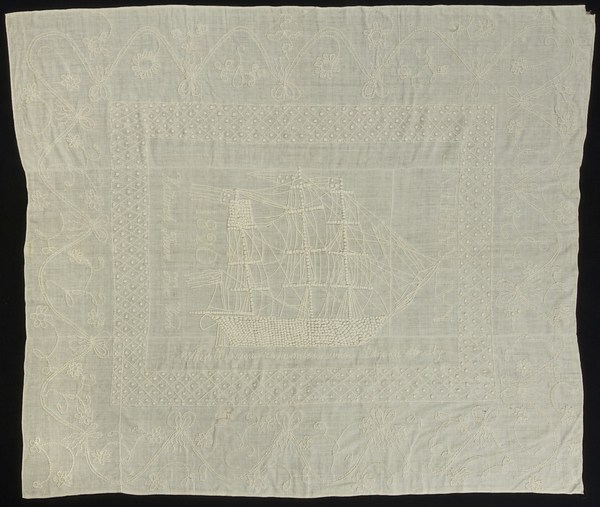
Katurah Reeve Her Work (1820) 1966.0139 overall. Courtesy of Winterthur Museum
The ship and its rigging are stitched with incredible realism. Katurah created the ship's roping by working the outline stitches at a very low angle. Other areas were worked using cut looped stitches and French knots.
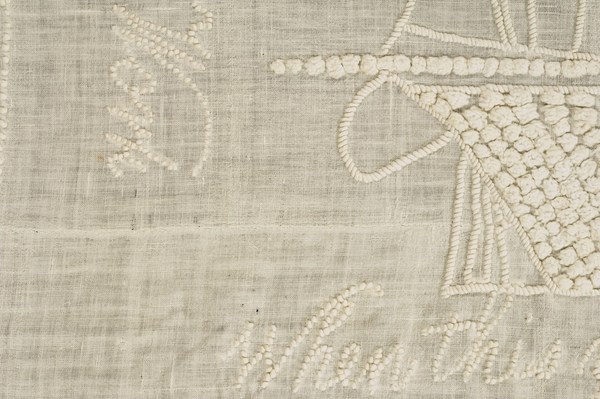
Katurah Reeve Her Work (1820) 1969_0236 detail 1. Courtesy of Winterthur Museum
The Patriot, the ship pictured in the bedcover, made headlines in newspapers up and down the East Coast on October 25, 1819; apparently, the Reeve family of Newburgh, NY, had relatives who were connected with this vessel. While en route from Mobile, AL, it was discovered that almost the entire crew had contracted yellow fever and that the ship had developed a major leak. A nearby Swedish ship, the Wilhelmine Catherine, rescued all the Patriot's crew. The article in the New York Evening Post from November 24, 1819 described the scene:
"On the 25th of October, fell in with the sloop Patriot, of New-York, captains Shiars, from Mobile bound to New York, in ballast; she was laying-to, with her colors half-mast, union down, in distress--wore ship and spoke her; on hailing, was informed she had sprung a leak, all hands sick but two, making so much water that she could not be kept free, and had all her sails split to pieces--captain S. and all hands, being compelled to abandon her, at their request, Captain Berg (of the Swedish ship Wilhelmine Catherine) took them on board, to save their lives, together with their effects, and brought them to this port.
Not all bedcoverings told such dramatic stories. Many examples feature popular motifs of the time: fruit-filled urns, medallions of flowers, swags, tassels, and floral and grape vines. It is extraordinary what the makers of these stunning bedcoverings were able to create using the most simple of elements.
My sincere thanks to the Winterthur Museum for so graciously sharing images from their whitework textile collection. To learn more about the Winterthur, click here.




.jpg)



RSS feed for comments to this post